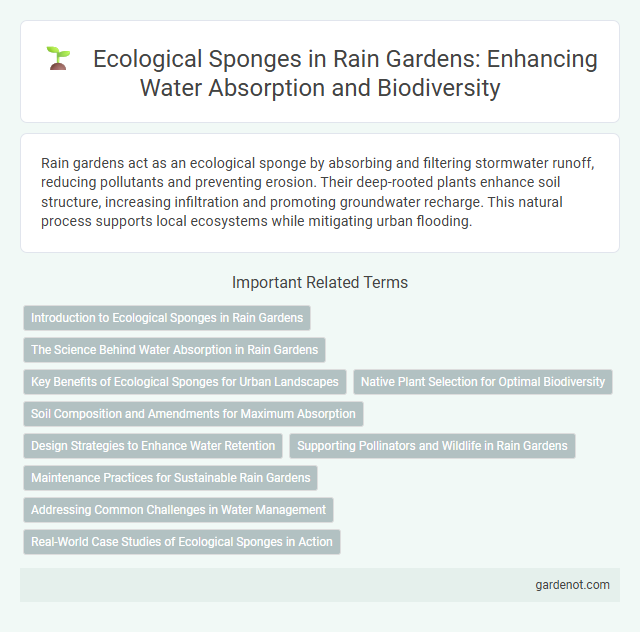Rain gardens act as an ecological sponge by absorbing and filtering stormwater runoff, reducing pollutants and preventing erosion. Their deep-rooted plants enhance soil structure, increasing infiltration and promoting groundwater recharge. This natural process supports local ecosystems while mitigating urban flooding.
Introduction to Ecological Sponges in Rain Gardens
Ecological sponges in rain gardens consist of layers of soil, compost, and mulch designed to absorb and filter stormwater runoff effectively. These sponges enhance groundwater recharge by trapping pollutants and slowing water flow, which reduces erosion and urban flooding. Their capacity to retain moisture supports plant health and promotes biodiversity within urban ecosystems.
The Science Behind Water Absorption in Rain Gardens
Rain gardens function as ecological sponges by mimicking natural hydrological processes to absorb and filter stormwater runoff. Their engineered soil layers and native plant roots enhance infiltration rates, reducing surface water volume and improving groundwater recharge. This biofiltration system captures pollutants, supports microbial activity, and mitigates urban flooding by slowing water flow through complex soil-plant interactions.
Key Benefits of Ecological Sponges for Urban Landscapes
Ecological sponges significantly enhance urban landscapes by improving stormwater management through effective water absorption and filtration, reducing runoff and pollution. These systems support biodiversity by creating habitats for native plants and wildlife, thereby promoting ecological balance within city environments. Moreover, ecological sponges contribute to urban heat island mitigation and increase groundwater recharge, improving overall urban resilience and sustainability.
Native Plant Selection for Optimal Biodiversity
Native plant selection in rain gardens enhances the ecological sponge effect by promoting water infiltration and reducing runoff. Deep-rooted native species improve soil structure, increase microbial activity, and provide critical habitats for pollinators and local wildlife. Choosing region-specific plants ensures resilience to local climate conditions and supports optimal biodiversity in the rain garden ecosystem.
Soil Composition and Amendments for Maximum Absorption
Rain garden soil composition is crucial for optimizing water absorption, typically consisting of a mix of sand, compost, and topsoil to create an ecological sponge that enhances infiltration and reduces runoff. Incorporating organic amendments like compost increases soil porosity and microbial activity, promoting nutrient retention and pollutant filtration. Properly balanced soil amendments improve water retention rates by up to 30%, ensuring efficient stormwater management and supporting native plant growth.
Design Strategies to Enhance Water Retention
Rain gardens function as ecological sponges by utilizing native plant species with deep root systems to maximize soil infiltration and water retention. Integrating layers of amended soil and organic mulch enhances permeability and slows runoff, promoting groundwater recharge. Strategic placement in low-lying areas and use of contouring directs stormwater into the garden, increasing absorption and reducing urban flooding.
Supporting Pollinators and Wildlife in Rain Gardens
Rain gardens act as ecological sponges by capturing and filtering stormwater, creating thriving habitats that support diverse pollinators such as bees, butterflies, and hummingbirds. Native plants in rain gardens provide essential nectar and pollen resources, promoting biodiversity and sustaining local wildlife populations. These green spaces improve urban ecosystems by offering shelter and food sources, contributing to healthier pollinator communities and enhanced ecological resilience.
Maintenance Practices for Sustainable Rain Gardens
Rain gardens function as ecological sponges by capturing and filtering stormwater through native plants and engineered soil layers, promoting groundwater recharge and reducing runoff pollution. Maintenance practices such as regular sediment removal, invasive species control, and replanting with native flora are essential to sustain their water absorption and filtration capacity. Proper upkeep of these rain gardens ensures long-term ecological benefits, including improved urban water quality and enhanced biodiversity.
Addressing Common Challenges in Water Management
Rain gardens function as ecological sponges by absorbing and filtering stormwater, reducing urban runoff and preventing flooding. They address challenges in water management by enhancing groundwater recharge and decreasing pollutant loads entering waterways. Incorporating native plants and engineered soil layers maximizes infiltration and supports biodiversity while mitigating water pollution.
Real-World Case Studies of Ecological Sponges in Action
Rain gardens function as effective ecological sponges by capturing and filtering stormwater runoff, reducing urban flooding and improving water quality. In Portland, Oregon, extensive rain garden networks have reduced peak stormwater flows by up to 60%, demonstrating significant flood mitigation and pollutant removal. Similarly, Melbourne's urban rain garden projects have enhanced groundwater recharge while supporting local biodiversity through native plant species integration.
Ecological sponge Infographic

 gardenot.com
gardenot.com